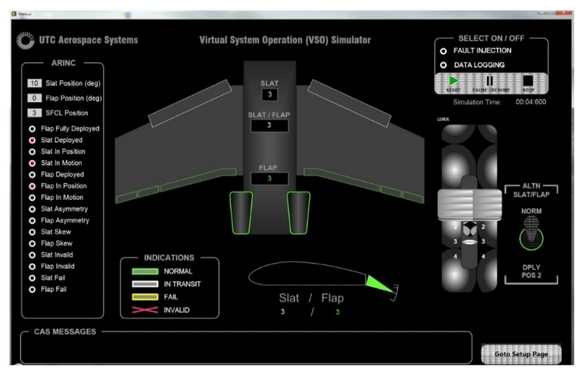NI Platform Used to Develop Unified Test Architecture for Commercial Aircraft
- Apr 6, 2023
- 4 min read
Updated: May 8, 2024
As Featured on NI.com
Original Authors: Scott Christensen, Collins Aerospace
Edited by Cyth Systems

The Challenge
Collins Aerospace needed to create a “cradle to grave” test architecture for electromechanical systems that was flexible enough to use for a wide range of aerospace controller and component tests across the product development cycle on new and existing programs.
The Solution
We standardized on the NI PXI and CompactRIO hardware platforms and LabVIEW software to provide a modular test architecture that could be easily configured, customized, and maintained. We collaborated with NI Alliance Partners Wineman Technology on the software and Sierra Peaks on the instrumentation and actuation.

Aerospace Test Needs
Aerospace line replaceable units (LRUs), components, and controllers require rigorous test, and aerospace companies like Collins Aerospace must test a wide range of configurations and variants of one type of part for a variety of OEM vehicle programs, from business jets to commercial airliners to military aircraft. Collins Aerospace designs many of components used in aircraft flight systems. The actuation group designs systems that translate cockpit control commands into movement of all the leading and trailing edge control surfaces (flaps, slats). These systems are comprised of slat and flap electronic control units (SFECUs), central power drive units (PDUs) and associated power transmission elements like torque tubes and gear boxes. All these system components need to be tested individually and in combination at the system and aircraft levels.
This test configuration and LabVIEW user interface (UI) management screen demonstrates the variety of devices under test that can be handled with this common architecture and how an application can be configured on the subsystem level.
Challenges of a Traditional Test Approach
The design and test methodology from component to component is relatively similar. However, those of us in the actuation group were operating many test stands for various types of LRU test, including development, qualification, production, and repair. Furthermore, we were operating with hydraulic loading on big test systems (both for internal use and for customers) that were time consuming and costly to reconfigure. We were losing time re-creating architectures and procedures to run different tests across the product development cycle.
For example, existing stands used hydraulic loading for mechanical LRU test. We were seeing a lot of similar rework across tests; we needed to replumb hydraulic systems and rewire whenever we wanted to reconfigure our test setup. Even for electronic test, the test stands required actual flight hardware, which made the test solutions rigid and inflexible. Automated test was minimal, and support for multiple configurations was limited. The “traditional approach” to test was costly and time consuming. Our group faced aggressive schedule and resource constraints that simply did not allow us to adapt the fragmented existing architecture quickly enough to meet the growing requirements. Also, Collins Aerospace still needed a competitive advantage over other suppliers to reduce cost and schedule to win future programs, so were driven to develop a new test architecture.
The Benefits of a Common Test Platform Across the Design Cycle
The upfront work and investment we put into our new distributed, deterministic, and dynamic (D3) architecture was a forward-looking approach that will pay off in the years to come. We saw great potential to optimize tests by standardizing on a common test architecture for all tests across the design cycle for a component. We implemented the following test types with the D3 architecture: model-in-the-loop (MIL), software-in-the-loop (SIL), and hardware-in-the-loop (HIL) tests; hardware and software validation and verification (V&V) test (fault insertion); life-cycle durability test; system integration lab (iron bird) test; aircraft-level system integration test; high-lift system test rig (HLSTR) including aircraft-level physical system test; system test rig (STR) including performance, endurance, and fatigue tests; slat/flap controller rig (SFCR) including software development, fly-the-box, software functional, software regression, system, and automated production (acceptance test procedures or ATP) tests; and physical tests including single wing and “right side” emulating tests based on total loading on left side.
We achieved several goals. First, we created a single common test platform that provides a “cradle to grave” test architecture and multipurpose tester. We used the same SFECU rig across the entire design “V” for development, ATP, iron bird test, system integration test stand (SITS) test, full production electronic controller test, and full production mechanical hardware test. Second, we incorporated modular hardware that is maintainable and reconfigurable. Now we can easily expand for larger system qualifications, reconfigure for different systems, and avoid hard wiring or plumbing to connect system components. Third, we have an open software architecture that is easy to integrate. The reflective memory architecture allows us to completely control our test stands with memory reads and writes. We can use this architecture separately or integrate it into larger test systems, and we can achieve distributed control that allows for more processing power as the system grows.
Collins Aerospace Cost, Time, and Labor Savings
By using NI’s distributed measurement and control products, we were able to cut test reconfiguration times from weeks to a day. Our D3 architecture is multipurpose (same load tables used for system, ATP, and iron bird; same SFECU rig used for development, ATP, iron bird, SITS, ESIM), modular (no hard wiring or plumbing to connect; software and hardware are built on designs common to multiple aircraft), easy to integrate (open software architecture; script writing in any language; proven RFM architecture that allows test stand to run in segregated or integrated mode), maintainable (eliminates traditional harness construction through extensive use of printed wiring boards), and forward looking (our team has patentable designs).
By developing a common test platform to address our HIL, V&V, system integration, and production test needs across a variety of projects and even aircraft architectures, we were able to cut our test equipment development time while positioning ourselves to better address future needs including a more digital test lab. We’ve saved months of development time and hundreds of thousands of dollars on new platforms while operating with less test lab labor. We’ve perfected an architecture on which an entire test lab can run on a series of mobile common front ends, which eliminates the problem of aging, stationary electronics designed for a single function on a single mechanical test bed. Now we are striving to complete the integration of this new architecture into our daily technical and business systems to achieve a fully automated test lab where concerns over labor rates are a thing of the past, which frees investment for further innovation.
Original Authors:
Scott Christensen, Collins Aerospace
Edited by Cyth Systems








